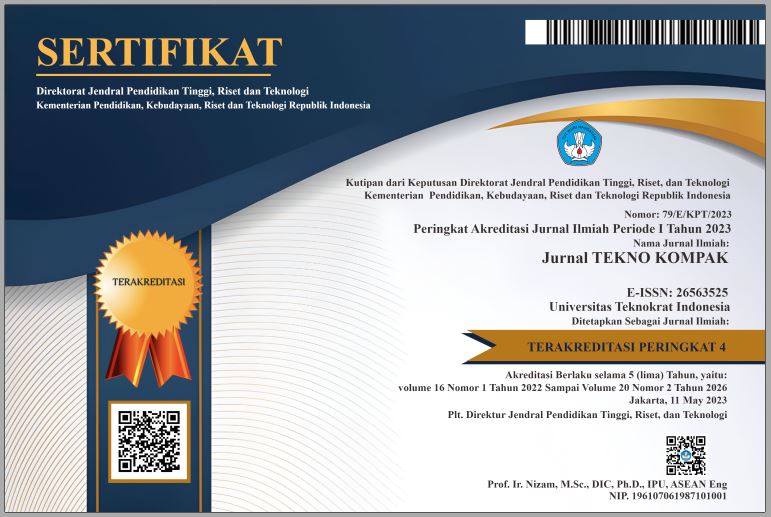Implementing Online Ordering Systems for Small Culinary Businesses: A Case Study of Nasi Cia
Abstract
Full Text:
PDFReferences
B. M. Wibawa, G. Anggadwita, R. R. Mardhotillah, S. N. Husin, A. Z. Komara Putri, and S. L. Putri, “Gojek VS Grab: Which One Is Better in Creating Customer Satisfaction and Loyalty?,” Bus. Financ. J., vol. 7, no. 1, pp. 11–24, 2022, doi: 10.33086/bfj.v7i1.2607.
M. Marwiyah, P. Puji Arti, and T. Hidayat, “An Analysis of Online Transportation Applications Between Gojek and Grab for Students,” Int. J. Sci. Educ. Cult. Stud., vol. 1, no. 1, pp. 52–64, 2022, doi: 10.58291/ijsecs.v1i1.28.
A. Yanto and N. Asiah, “Customer Relationship Management (CRM) Based On Web To Improve The Performance Of The Company,” IAIC Trans. Sustain. Digit. Innov., vol. 1, no. 1, pp. 32–41, 2021, doi: 10.34306/itsdi.v1i1.7.
A. Alamäki and P. Korpela, “Digital transformation and value-based selling activities: seller and buyer perspectives,” Balt. J. Manag., vol. 16, no. 2, pp. 298–317, 2021, doi: 10.1108/BJM-08-2020-0304.
M. Uribe and B. Feinberg, “The Effect Of Online Advertising On Consumer Buying Interest In Online Selling Applications With Customer Satisfaction As An Intervening Variable,” Med. Res. Nursing, Heal. Midwife Particip., vol. 01, no. 04, pp. 96–102, 2023.
M. Mandviwalla and R. Flanagan, “Small business digital transformation in the context of the pandemic,” Eur. J. Inf. Syst., vol. 30, no. 4, pp. 359–375, 2021, doi: 10.1080/0960085X.2021.1891004.
D. S. Wuisan and T. Handra, “Maximizing Online Marketing Strategy with Digital Advertising,” Startupreneur Bus. Digit. (SABDA Journal), vol. 2, no. 1, pp. 22–30, 2023, doi: 10.33050/sabda.v2i1.275.
F. H. Gazzawe, “Comparison of websites and mobile applications for. International Conference on Technology in EducationNo Title,” in 2017 IACB, 2017 ICE & 2017 ICTE Proceedings, 2017.
I. Almarashdeh et al., “The difference between shopping online using mobile apps and website shopping: A case study of service convenience,” Int. J. Comput. Inf. Syst. Ind. Manag. Appl., vol. 11, pp. 151–160, 2019.
I. Almarashdeh et al., “Search Convenience and Access Convenience: The Difference Between Website Shopping and Mobile Shopping,” Adv. Intell. Syst. Comput., vol. 942, pp. 33–42, 2020, doi: 10.1007/978-3-030-17065-3_4.
A. Wong, … S. W.-J. of E. and D. using, and undefined 2016, “A cross-cohort exploratory study of a student perceptions on mobile phone-based student response system using a polling website,” Learntechlib.Org, vol. 12, no. 3, pp. 58–78, 2016, [Online]. Available: https://www.learntechlib.org/p/174310/
S. Chou and H. Min, “Evaluating Web Site Performance In Internet-Based Selling From A Business Value Perspective,” Underst. client ’ s Commit. Bus. Process outsourcing relationships, pp. 227–228, 2012.
A. Akhtar, B. Bakhtawar, and S. Akhtar, “Extreme Programming Vs Scrum: a Comparison of Agile Models,” Int. J. Technol. Innov. Manag., vol. 2, no. 2, pp. 80–96, 2022, doi: 10.54489/ijtim.v2i2.77.
A. Shrivastava, I. Jaggi, N. Katoch, D. Gupta, and S. Gupta, “A Systematic Review on Extreme Programming,” J. Phys. Conf. Ser., vol. 1969, no. 1, 2021, doi: 10.1088/1742-6596/1969/1/012046.
D. J. C. Sihombing, “Analysis and development of the ProTrack application: construction timeline management using Extreme Programming Methodology,” J. Mantik, vol. 7, no. 2, pp. 2685–4236, 2023.
W. Istiono, “Efficient Thesis Management : A Study of Universitas Multimedia Nusantara ’ s Application Development Using Extreme Programming Principles,” vol. 6, no. 2, pp. 639–651, 2024, doi: 10.51519/journalisi.v6i2.701.
C. Fagarasan, O. Popa, A. Pisla, and C. Cristea, “Agile, waterfall and iterative approach in information technology projects,” IOP Conf. Ser. Mater. Sci. Eng., vol. 1169, no. 1, p. 012025, 2021, doi: 10.1088/1757-899x/1169/1/012025.
M. Ibrahim et al., “Presenting and Evaluating Scaled Extreme Programming Process Model,” Int. J. Adv. Comput. Sci. Appl., vol. 11, no. 11, pp. 163–171, 2020, doi: 10.14569/IJACSA.2020.0111121.
W. Istiono and J. Sampurna, “Notification information system android-based for spreading school information,” Telkomnika (Telecommunication Comput. Electron. Control., vol. 19, no. 3, pp. 747–753, 2021, doi: 10.12928/TELKOMNIKA.v19i3.18326.
I. Kusmaryono, D. Wijayanti, and H. R. Maharani, “Number of Response Options, Reliability, Validity, and Potential Bias in the Use of the Likert Scale Education and Social Science Research: A Literature Review,” Int. J. Educ. Methodol., vol. 8, no. 4, pp. 625–637, 2022, doi: 10.12973/ijem.8.4.625.
L. South, D. Saffo, O. Vitek, C. Dunne, and M. A. Borkin, “Effective Use of Likert Scales in Visualization Evaluations: A Systematic Review,” Comput. Graph. Forum, vol. 41, no. 3, pp. 43–55, 2022, doi: 10.1111/cgf.14521.
J. Mumu, B. Tanujaya, R. Charitas, and I. Prahmana, “Likert Scale in Social Sciences Research: Problems and Difficulties,” FWU J. Soc. Sci., vol. 16, no. 4, pp. 89–101, 2022, doi: 10.51709/19951272/Winter2022/7.
DOI: https://doi.org/10.33365/jtk.v19i1.4663
Refbacks
- There are currently no refbacks.
Copyright (c) 2024 Charisma Christ Anugrah, Wirawan Istiono

This work is licensed under a Creative Commons Attribution-ShareAlike 4.0 International License.
Jurnal Tekno Kompak
Published by Universitas Teknokrat Indonesia
Organized by Program Studi D3 Sistem Informasi Akuntansi - Universitas Teknokrat Indonesia
Jl. Zainal Abidin Pagaralam, No.9-11, Labuhanratu, Bandarlampung, Indonesia
Telepon : 0721 70 20 22
W : http://ejurnal.teknokrat.ac.id/index.php/teknokompak
E : teknokompak@teknokrat.ac.id.
This work is licensed under a Creative Commons Attribution-ShareAlike 4.0 International License.
Jumlah Pengunjung : View Tekno Kompak StatsCounter
















